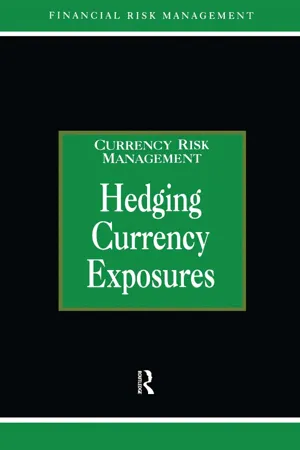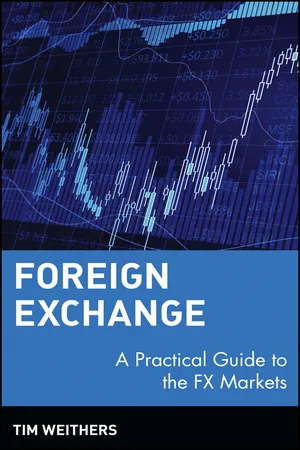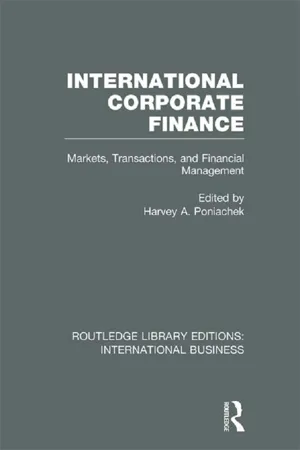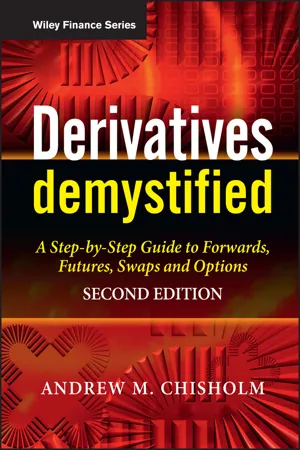Cross Currency Swap
A cross currency swap is a financial agreement between two parties to exchange interest and principal payments in different currencies. This allows each party to access a desired currency without having to engage in foreign exchange transactions. Cross currency swaps are commonly used by businesses to manage currency risk and to secure more favorable borrowing terms in different markets.
7 Key excerpts on "Cross Currency Swap"
- eBook - ePub
Accounting for Investments, Volume 2
A Practitioner's Handbook
- R. Venkata Subramani(Author)
- 2011(Publication Date)
- Wiley(Publisher)
...A cross-currency basis swap is an exchange of a fixed or floating rate note in one currency for a fixed or floating rate note in another currency. It may involve swapping payments in one currency for payments in another. At maturity the notional principal may also be swapped. Features of cross-currency swap The tenure of a cross-currency swap typically ranges from one to fifteen years. Cross-currency swaps are suitable for entities that have loan commitments denominated in one currency, while the revenues generated by the entity are denominated in a different currency, resulting in a currency mismatch between the currency of the loan and the currency of the revenues. Cross-currency swaps are available in different currency pairs. Effectively, a cross-currency swap serves as an excellent hedging strategy for hedgers who wish to protect against both the currency rates as well as interest rate risks. Benefits of a cross-currency swap A Cross-currency interest rate swap allow an entity to switch its loan from one currency to another. A Cross-currency interest rate swap enable an entity to manage foreign currency exposures. With a cross-currency swap the entity can use money it receives in one currency to pay off its loans in another currencycross-currency. The entity can focus on raising debt in the domestic market where it has its own strengths and still be able to swap the domestic local currency debt with any foreign currency with a cross-currency swap, thus effectively procuring foreign currency funds at low costs. Risks involved in a cross-currency swap Interest rate risk: Since a cross-currency swap is basically an interest rate swap, all the risks associated with an interest rate swap in terms of interest rates do exist in this instrument...
- eBook - ePub
- Alastair Graham, Alastair Graham(Authors)
- 2014(Publication Date)
- Routledge(Publisher)
...Currency Swaps A swap is an agreement between two parties for the exchange of a stream of cash flows over a specified term. One of the parties to the contract is normally a specialist bank. Currency swaps involve the exchange of a stream of cash flows in one currency for a stream of cash flows in a different currency. Elements in a Swap A currency swap consists of three or sometimes just two main elements. ● There is an exchange of principal at the beginning of the swap. One party gives the other a quantity of one currency in exchange for a second currency at an agreed rate of exchange, normally at or close to the current spot rate. One of the two currencies involved is commonly the dollar. ● At regular intervals, normally six monthly or annually, there is an exchange of payments. It is convenient to think of these as interest payments on the swapped amounts of principal, although swaps are not loans. The amount to be exchanged by each party is calculated at a swap rate (interest swap) on the amount of principal exchanged. This might be a fixed rate or a floating rate. ● At the end of the term of the swap, there is a re-exchange of the principal amounts, with each party repaying the currency that was received at the start of the swap period. The rate of exchange is therefore exactly the same as for the initial exchange of principal. Many currency swap agreements do not involve a physical initial exchange of principal at the start of the swap, just a notional exchange on nominal amounts of each currency. Start of swap (near-value date): Initial exchange of principal at £ 1 =$1.60 Many swaps do not involve an exchange of principal at the start of the swap term. If the parties wish to obtain the currency they can buy it in the spot FX market. Interest exchange (six-monthly): End of swap (fair-value date): Re-exchange of principal Hedging with Swaps Currency swaps are long-term instruments, typically with a term of between two and 10 years...
- eBook - ePub
Foreign Exchange
A Practical Guide to the FX Markets
- Tim Weithers(Author)
- 2011(Publication Date)
- Wiley(Publisher)
...The most common is simply a standard FX forward trade with an offsetting FX spot transaction. The more interesting type of FX swap is the cross-currency swap or cross-currency interest rate swap or bond swap. These are often used in conjunction with international debt issuance and can result in lower borrowing costs both at home and abroad. Having said that, cross-currency swaps may be used to lock in the exchange rate for a series of firm commitment cash flows from operations; they may also be used for speculative purposes. Ultimately, though, cross-currency swaps are simply bundlings of FX forward contracts, and so introduce nothing new beyond our earlier spot-forward valuation relationship (aside from possibly interest rate compounding considerations); it is useful to keep this in mind for currency swap valuation and revaluation purposes....
- eBook - ePub
International Corporate Finance (RLE International Business)
Markets, Transactions and Financial Management
- Harvey A Poniachek, Harvey A Poniachek(Authors)
- 2013(Publication Date)
- Routledge(Publisher)
...PART V UTILIZING CURRENCY SWAPS AND OPTIONS 14 Currency Swaps Frank Ribeiro DOI: 10.4324/9780203076590-19 A SWAP is a financial transaction in which two counterparties agree to exchange streams of payments over time. The two main types are currency swaps and interest-rate swaps. In a currency swap two counterparties exchange specific amounts of two different currencies at the beginning and repay according to a schedule that includes either fixed- or floating-rate interest payments and the repayment of principal. In some cases there is no exchange of currencies initially. Only on rare occasions is principal not exchanged at maturity. 1 The interest-rate swap is a specialized form of currency swap in which a single currency is involved. Only the interest-rate structure of the two exchanged flows are different. The principal amounts, being in the same currency, are netted to zero and thus become only notional concepts. No actual principal is exchanged either initially or at maturity, but interest payments are exchanged calculated on the underlying notional principal amount. The main types of transactions are coupon swaps, where a party pays fixed interest-rate payments and receives floating-rate payments, and basis swaps, where the interest payments exchanged are calculated from two different floating-rate indexes (such as the three-month dollar LIBOR against the U.S. commercial-paper composite rate). This chapter will focus on the currency swap, but the concepts and principles also apply to interest-rate swaps. Background The currency swap as we know it today was totally unknown to the financial markets as recently as the mid-1970s. Before that time companies unsophisticated in managing the foreign-exchange exposures created by the new system of floating exchange rates devoted their resources to building tools and strategies for the more immediate needs of managing their foreign-currency working capital. U.S...
- eBook - ePub
Derivatives Demystified
A Step-by-Step Guide to Forwards, Futures, Swaps and Options
- Andrew M. Chisholm(Author)
- 2011(Publication Date)
- Wiley(Publisher)
...6 Interest Rate Swaps INTRODUCTION In general terms a swap is a contract between two parties: • agreeing to exchange cash flows; • on regular dates; • where the two payment legs are calculated on a different basis. A swap is a bilateral over-the-counter (OTC) agreement directly negotiated between two parties, at least one of which is normally a bank or other financial institution. Once made, the contract cannot be freely traded. On the other hand, it can be tailored to meet the needs of a particular counterparty. As with other OTC derivatives there is a potential credit risk - the risk that the other party to the deal might default on its obligations. Clearing Arrangements for OTC Derivatives Following the 2007/8 ‘credit crunch’ regulators in the US and elsewhere have pressed derivatives dealers to increase the use of central clearing arrangements for OTC derivative trades such as swaps. This involves registering an OTC transaction with a clearing house which then acts as central counterparty, taking collateral and guaranteeing the deal against the risk of default. This topic is discussed further in Chapter 20. In an equity swap (see Chapter 7) one payment leg is based on the price of a single stock or on the level of a stockmarket index such as the S&P 500. In a commodity swap one leg is based on the price of a physical commodity such as oil. In an interest rate swap (IRS) both payment legs are based on interest rates. Swaps of all kinds are used by corporations, investors and banks to manage their exposures to interest rates, currency exchange rates, share values, commodity prices and loan default rates. They can also be used to take speculative trading positions. INTEREST RATE SWAP STRUCTURE The most common type of swap is a single-currency IRS in which the payment made by one party is based on a fixed interest rate, and the return payment is based on a variable or floating rate...
- eBook - ePub
Derivatives
Theory and Practice
- Keith Cuthbertson, Dirk Nitzsche, Niall O'Sullivan(Authors)
- 2019(Publication Date)
- Wiley(Publisher)
...We ensure that the swap rate in domestic currency (USD) and the swap rate in the foreign currency (Euros) give a zero value (in USD or Euros) at inception for the currency swap. The two swap rates in a fixed-fixed currency swap are the same as the swap rates on fixed-for-floating vanilla interest rate swaps in the respective countries. Cash flows in a fixed-fixed currency swap are equivalent to taking a long and short position in a domestic and foreign bond, respectively. This ‘synthetic swap’ enables one to calculate the value of a currency swap during the remaining life of the swap. Equivalently, the swap can be viewed as a strip of forward-FX contracts. Both methods give the same market value for the swap, at any time after inception. Changes in interest rates in either country but especially changes in the exchange rate, lead to a change in the (mark-to-market) value of a currency swap. Swap dealers (usually banks) take on one side of a swap contract and they will try and match the cash flows incurred, with other swap counterparties. If the swap dealer cannot immediately find a matching counterparty to a currency swap she can hedge her net position in any currency. She can use currency futures contracts to hedge exchange rate risk and interest rate futures to hedge the interest rate risk in the two countries (which change the present value of the swap). The main risk to a swap dealer who does not have a matched swaps book in each currency comes from volatile exchange rates. APPENDIX 36.A: PRICING A CURRENCY SWAP Consider a currency swap to pay-fixed USD and receive-fixed Euros...
- eBook - ePub
The Front Office Manual
The Definitive Guide to Trading, Structuring and Sales
- A. Sutherland, J. Court(Authors)
- 2013(Publication Date)
- Palgrave Macmillan(Publisher)
...This explains the shift we saw in the forward points for EUR/USD. Another way of looking at the constant-notional basis swap is as a way to borrow one currency, using another currency as collateral. In Figure 7.2, the customer is borrowing US dollars, using Euros as collateral. The bank is not paying a very good rate of return on the Euros it’s holding, presumably because it is not happy at having to give up dollars. How does this relate to the FX market? Figure 7.3 shows that the basis swap and the FX forward are two different views of the same thing. The two columns on the left show a hypothetical 3-month basis swap. The payments at the start and end exactly match the forward FX market. The difference between a constant-notional basis swap and an FX swap is the coupon schedule. The basis swap pays interest every 3 months (on both sides), whereas the FX swap only pays at the end. Figure 7.2 Payments in a constant-notional basis swap The advantage, then, of the basis swap is that the notional amounts are fixed, and the interest rate component is separated. The basis swap market offers banks (and others) an easy way to borrow other currencies on a long-term basis. For instance, suppose I am a French corporation that wishes to issue debt in the UK market. I will issue a bond, paying a fixed rate of interest, for say 10 years, in Sterling (GBP). I’ll sell that bond to UK buyers, who will pay me Sterling, and I will then pay them (in Sterling) the fixed coupon rate on the bond (5%, for instance) every year, with the final repayment in 10 years. The French corporation, however, may prefer to pay interest in Euros, at the prevailing Euro interest rate (3-month EURIBOR plus a spread, for instance). The easy way to do that would be to first purchase a standard UK interest rate swap to convert the GBP fixed payments into GBP LIBOR (plus a spread) payments...






